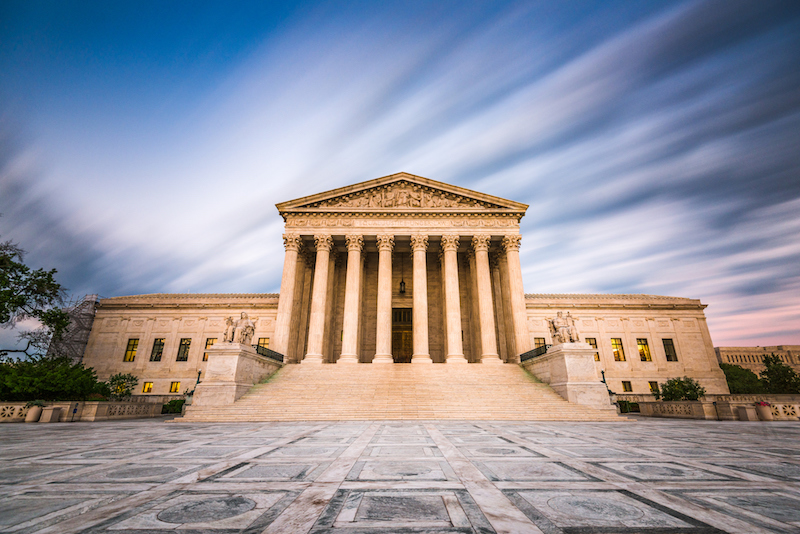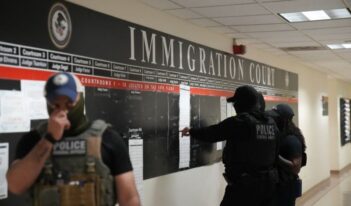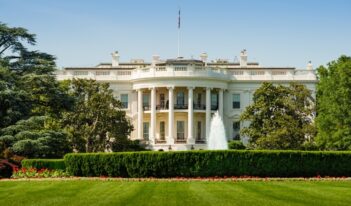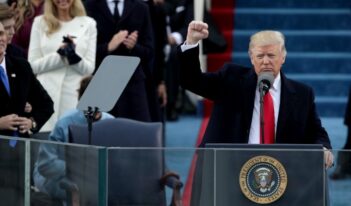
The Supreme Court should follow the Fourth Circuit in prohibiting impermissible animus while maintaining the President’s discretion.
Earlier this week, the U.S. Supreme Court heard oral arguments in Hawaii v. United States, the dispute over the validity of the injunction issued to bar the government from implementing the third of President Donald Trump’s “travel bans.” These travel bans—initiated respectively by two executive orders and a presidential proclamation—illustrate well the tension among three goals that the judiciary must attempt to pursue simultaneously with respect to a variety of actions undertaken by the Trump White House: prohibiting actions based on unconstitutional bias, respecting the lawful discretion of the elected president, and avoiding establishment of precedents that will unduly limit the discretion of future presidents.
The travel bans are a paradigmatic example of a presidential action that is entitled to extraordinary deference. The stated purpose of the travel bans is to protect national security by reducing the risk that terrorists can enter the United States from countries that are known to include a large number of terrorists and that have been determined to have ineffective systems of screening potential travelers to the United States.
The travel bans also are an excellent example of presidential actions that would violate constitutional prohibitions against discrimination based on religion if they were motivated by bias against Muslims. During his campaign and continuing after he took office, President Trump expressed extreme antipathy toward Muslims on numerous occasions. Each of the three bans had a disproportionate adverse effect on Muslims.
President Trump issued the first ban by executive order seven days after he took office. It temporarily banned all foreign nationals from entering the United States from seven predominantly Muslim countries. It was not preceded by any consultation with national security or immigration officials, and it was issued immediately after a conversation in which the President told Rudolph Giuliani that he wanted to ban all Muslims from entering the country and asked him how he could accomplish that result legally. President Trump also stated publicly that the ban would give preference to any Christian who wanted to enter the United States from a country that was on the banned list.
The second ban was issued via executive order six weeks after the first ban—and after several courts had enjoined the first ban. It removed Iraq from the banned list, and it announced that the Secretary of Homeland Security had been directed to investigate the procedures used by the other countries on the banned list to determine whether they were providing adequate information to the federal government about travelers to the United States.
The third ban was issued by presidential proclamation six months after the second ban—and after several courts had enjoined the second ban. It imposed indefinite duration bans on travelers attempting to enter the United States from any of the six primarily Muslim countries that were on the prior lists, but it added two non-Muslim countries to the banned list and exempted travelers who had visas or who qualified for visas. The government attempted to defend the third ban on the basis that it was justified by a study that the U.S. Department of Homeland Security (DHS) had reportedly conducted that found that each of the eight countries subject to the ban had inadequate systems for determining whether travelers to the United States posed terrorist risks. Notably, however, the government refused to make any report of the findings of the investigation available to the court.
The Supreme Court will have the last word in this case. However, the 285 pages of opinions issued by the full U.S. Court of Appeals for the Fourth Circuit in reviewing the third travel ban are valuable as windows into the difficulties that judges face in applying traditional public law doctrines in a manner that will simultaneously further the three goals that courts must attempt to further as they review actions taken by the Trump Administration.
One of the important goals of the courts should be to preclude President Trump from acting in accordance with his animosity toward Muslims. Yet courts will find it difficult to further that goal at the same time that they further two other important goals.
Courts should allow President Trump to take any lawful actions that are not rooted in his bias against groups or individuals. He was elected President. He should have the same degree of discretion to pursue his lawful goals and those of the citizens who elected him as any other President.
Courts should also refrain from issuing opinions that will have the effect of unduly limiting the discretion of President Trump’s successors. Bad Presidents can make bad precedents. We cannot afford to create limits on the power of future Presidents based on fear that the public is likely to elect other Presidents who share President Trump’s biases.
The full Fourth Circuit upheld the district court’s preliminary injunction of the third travel ban by a vote of nine to four. The majority emphasized the first goal of prohibiting official action based on religious bias. The four dissenting judges, on the other hand, emphasized the second and third goals of preserving discretion for the President to act in ways that he believes are needed to protect national security.
The dissenting judges relied primarily on statutory language that seemed to confer complete discretion on the President to “suspend the entry of all aliens or any class of aliens” any time that “he finds that the entry…would be detrimental to the interests of the United States.” They pointed to language in the proclamation that included such a presidential finding and that supported it by reference to the findings of the DHS investigation of the eight countries that were included in the ban. And they referred to over a century of judicial decisions that create “essentially no room for judicial intervention in immigration matters.”
The approach taken by the dissenting judges obviously does not further the goal of precluding the President from taking actions based on constitutionally impermissible biases. As the majority documented, there was massive evidence that the bans were motivated by unconstitutional religious bias.
The dissenting judges justified their decision to ignore that evidence by referring to the critical need to further the other two goals. They asserted that the majority’s use of the President’s statements to prove that his actions were motivated by impermissible bias will “leave the President and his Administration in an untenable position for future action” by precluding him from taking any future action to protect the nation from Muslim terrorists no matter how important the action might be. They also asserted that the narrow constructions that the majority gave to the statutes that authorize the President to protect national security by restricting the entry of aliens would “wreak havoc by precluding” future Presidents from taking actions that might be essential “if the United States were to enter a state of war with a foreign nation or were attacked by foreigners.”
The majority advanced two arguments in support of its decision to uphold the preliminary injunction. Some judges relied on only one of these two arguments, while others relied on both.
The first argument was based on a combination of the U.S. Constitution and President Trump’s numerous statements that vilified Muslims and expressed his desire to keep all Muslims out of the country. The judges who made this argument began by recognizing the President’s broad constitutional and statutory power over immigration and the heavy burden the plaintiffs had to bear to persuade a court to review a “facially legitimate” presidential restriction on entry of foreign nationals. They then referred to the “rare instances” in which the Supreme Court had authorized such review. In those rare instances, plaintiffs must make an “affirmative showing of bad faith” and do so “plausibly” and “with sufficient particularity.” “Upon such a showing, a court may ‘look behind’ the Government’s proffered justification for its action,” the judges noted. The judges then relied on President Trump’s statements to satisfy this requirement and to show that “the proclamation’s invocation of national security is a pretext for an anti-Muslim religious purpose.”
The second argument made by some of the judges in the majority was based on concern that, if interpreted literally, the statute that delegates to the president seemingly unreviewable discretion to restrict entry of foreign nationals would violate the non-delegation doctrine. They relied on the avoidance canon to support numerous narrow interpretations of the statutes.
The second argument fares poorly when it is evaluated with reference to the three goals that courts should attempt to further when they review actions taken by the Trump Administration. It does nothing to further the goal of protecting the country from actions that are motivated by President Trump’s animosity toward Muslims. It has potentially severe adverse effects on the other two goals: it might not allow President Trump to take otherwise lawful actions that are not motivated by constitutionally impermissible bias, and it might not allow future Presidents to exercise the discretion required to perform the many tasks of a chief executive effectively.
The dissenting judges’ criticisms of the majority resonate if they are considered with reference to the use of the non-delegation doctrine to justify adoption of narrow constructions of the statutes that empower the president to protect national security by controlling the entry of foreigners into the country. They “wreak havoc” with the ability of either President Trump or his successors to protect the nation from a wide variety of potential grave dangers to national security.
The first argument made by some of the judges in the majority fares much better when it is evaluated with reference to the three goals. It furthers the goal of protecting the country from actions that are based on constitutionally impermissible bias. It also does not conflict with the other two goals as long as judges combine it with the limits on judicial review of presidential actions that some of the majority judges acknowledged.
For example, one such limit is inherent in the way that the majority characterized the circumstances in which a court can rely on presidential statements as a basis to infer that the President acted on the basis of constitutionally impermissible bias. The judges in the majority emphasized the powerful presumption that a President acts for legitimate reasons and the rarity of the circumstances in which judges can rely on such evidence to overcome that presumption. They also emphasized the overwhelming nature of the evidence that rebutted that presumption in this case.
It is unlikely that any future President will be affected by the rare exception the majority relied on because it is unlikely that we will elect another President with the powerful unconstitutional animus that President Trump has evidenced against Muslims. If we do, an opinion like the majority opinion will provide an indispensable source of protection from actions that are based on the worst instincts of such a President.
Another important limit is illustrated by the majority’s implicit recognition that President Trump could have defended the bona fide nature of his asserted reasons for the third travel ban but failed to offer any credible evidence to support the stated reasons for the ban. The majority refused to give credence to the findings of the DHS investigation of the adequacy of the eight nations’ measures to assist the United States in protecting itself from foreign terrorists that enter the United States from those countries.
The majority viewed the findings the government ascribed to the DHS study, and the criteria the Department said it used to make its decision, as inconsistent with the predominance of Muslim majority countries that were subject to the ban. In addition, the majority noted that the government refused to make the results of the investigation available to the court. At oral argument, the government even disavowed any claim that the investigation “could save the proclamation.”
The judges’ discussion of the investigation strongly suggests that they would have upheld the travel ban if the government had made the study available to the court and if the findings and criteria provided plausible support for the ban.
As a final limit on judicial oversight of presidential immigration decisions, the judges in the Fourth Circuit majority recognized that “the President’s past actions cannot forever taint his future actions.” Specifically, they noted that
President Trump could have removed the taint of his prior troubling statements; for a start he could have ceased publicly disparaging Muslims.…In fact, instead of taking any actions to cure the “taint” that we found infected EO-2, President Trump continued to disparage Muslims and the Islamic faith.
The ability of some of the judges who were in the majority in the Fourth Circuit to identify a method of reasoning that furthers one of the goals—prohibiting actions based on religious bias—without seriously compromising the other goals—ensuring that Presidents retain sufficient discretion to act to protect national security—is broadly encouraging. There are many public law doctrines that allow judges to use similar reasoning. For instance, the presumption of regularity that attaches to all actions of federal agencies can be rebutted by evidence to the contrary, and the rule that limits courts to the use of the record before the agency when it reviews an agency action is subject to an exception when a petitioner makes a strong showing of bad faith or improper behavior by the agency.
The Fourth Circuit judges have demonstrated that it is possible to further all three goals that the judiciary should attempt to further in the travel ban litigation. When it rules on the travel ban, the Supreme Court should apply the sensible reasoning of the judges in the majority of the Fourth Circuit.




